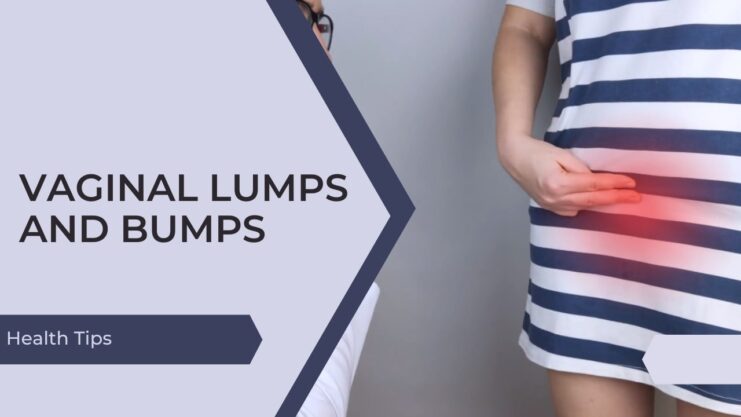It’s not uncommon for women to experience a moment of panic when they discover a lump or bump in their vaginal area. This sudden discovery can feel like a dark cloud has momentarily cast a shadow over their day. It’s a moment filled with uncertainty and anxiety, as the mind races to consider all the potential implications.
Often, these lumps or bumps are as innocent as benign cysts, akin to unexpected guests who show up uninvited, cause a bit of a stir, but ultimately leave without causing any harm. They might be a bit bothersome, but they’re generally harmless and can be managed with the help of a healthcare professional.
Sometimes, these lumps or bumps could be signs of an infection, like unwanted intruders trying to disrupt the harmony of your body. They might cause discomfort or other symptoms, but they’re usually manageable with the right treatment and care.
It’s like having a minor issue in your home that needs fixing – it might be inconvenient and a bit uncomfortable, but with the right tools and expertise, it can be resolved.
Harmless Bumps:
Harmless bumps in genital region include cysts, molluscum, vestibular papillomatosis (VP) and Fordyce spots.
Cysts
Ever felt a round lump that feels like a small pebble just under the skin over the vulva? This is usually a cyst. Cysts are painless unless infected. Sebacous cysts are caused by blocked hair follicles and ingrown hair from shaving or waxing.
Most sebaceous cysts can be left alone without treatment so long as it is not causing any problem. Sometimes they may enlarge or get infected and this may require a small incision.
Bartholin cyst developes when the vulvovaginal gland called Bartholin gland becomes blocked and causes it to swell. Problem arises when it becomes infected and forms an abscess. In such case, this requires a minor surgery that is usually done in hospital.
Molluscum Contagiosum
They are usually multiple pearly white to skin coloured tiny bumps and it may spread. These bumps are caused by a virus called pox virus. These lesions are harmless and will eventually go away, but it may 1-2 years. They are also common in children and can appear in other parts of the body.
When it occurs in adults, they may represent a sexually transmitted disease. In such cases, we normally advise to get tested for other STDs. Electrosurgery (laser), freezing (liquid nitrogen) and topical imiquimod 5% cream are some of the effective treatment options available.
Vestibular papillomatosis
VP appears as multiple shiny tiny papules arranged linearly and symmetrically typically over inner labia minor and vaginal opening. It is a normal variant of female genitalia, similar to pearly penile papules (PPP) in men. No treatment is needed.
However, they are commonly mistaken as genital warts as they can appear quite similar. A correct diagnosis of this condition is important to prevent undue stress and unnecessary tests and treatment. There are distinguishing features in VP that differentiates it from genital warts. Hence, it is important to get them checked by a medical professional.
Fordyce spots
These are enlarged oil glands that appear as small white to yellow lumps typically over labia minora. They are completely painless and harmless. These spots can be seen on the lining of your mouth and also sometimes on the penis in men.
Infection:

Lumps and bumps related to infections include folliculitis and STD related genital warts, syphilis and herpes.
Folliculitis
These tender red spots often with surface pustule can develop over labia region when the hair follicles becomes inflamed and infected.
They can be caused by bacterial, fungal or even viral infection such as herpes or irritation from ingrown hair due to shaving, and waxing. Treatment depends on the underlying condition.
Genital warts
Genital warts are caused by Human papilloma virus (HPV), typically type 6 and 11 and they are contagious via skin to skin contact. They present as small, skin-colored bumps that develop either as a single lump or (usually) multiple.
The course of the condition varies between individuals. In some, the warts may eventually go away,some may stay the same, or spread and become more in number.
Syphilis
They typically appear as a painless sore in the genital area or on the lips and mouth, also known as chancre. It is usually sexually transmitted and caused by bacterial infection.
The sore can eventually go away within a few weeks even without treatment. However, the infection is still there and not cured. Serious complications can develop if left untreated
Herpes
Herpes appears as multiple clustered painful blisters or ulcers in the genital area. Herpes infection is treatable but not curable. Hence, the blisters may recur multiple times, some more frequent than others.
It is contagious and can spread to partners easily even with use of condoms. Medications such as anti-viral can effectively treat and prevent outbreaks.
Malignancy

Vaginal Cancer
Last but not least, vaginal or vulva cancer can also present as a lump or bump in vagina. However, usually they are accompanied with other symptoms such as abnormal vaginal bleeding or discharge and pain during intercourse. In such cases, a pelvic examination and pap smear is done to look for any red flags.
Vaginal Melanoma
Although not common, vaginal melanoma can appear as a pigmented lump. 2% of melanoma are diagnosed in vagina or vulva. However, this is usually more common in women older than 50. Sometimes, it causes non-specific symptoms like itching, bleeding or pain.
Final Words
In conclusion, while discovering a lump or bump in the vaginal area can be a cause for concern, it’s important to remember that many of these are harmless or treatable conditions. Whether it’s a benign cyst, an infection, or a symptom of a sexually transmitted disease, medical science has a range of effective treatments and interventions available.
However, it’s crucial to seek medical advice if you notice any changes or have any concerns. Regular check-ups and open communication with your healthcare provider can help ensure that any potential issues are identified and addressed promptly. Remember, your health is in your hands, and proactive steps can make a world of difference.












